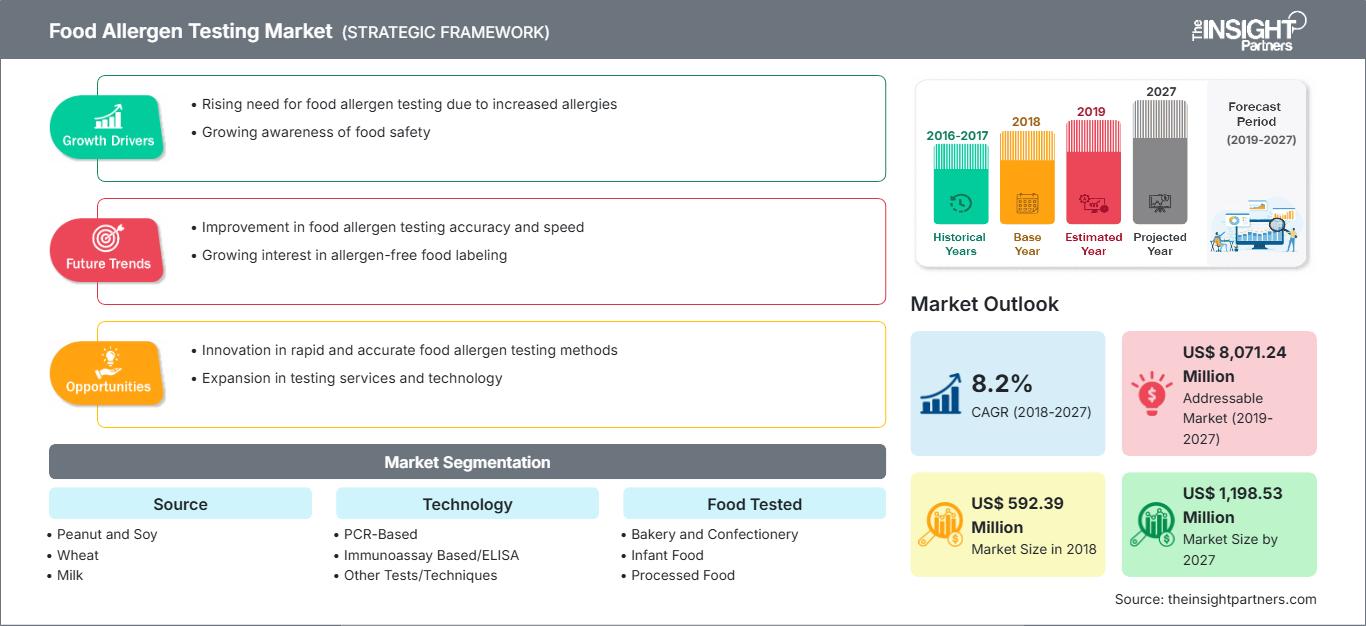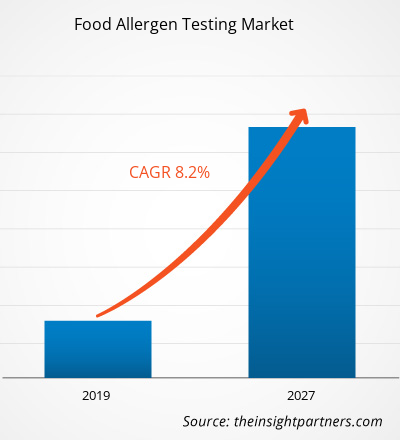Il mercato dei test per gli allergeni alimentari è stato valutato a 592,39 milioni di dollari nel 2018 e si prevede che raggiungerà i 1.198,53 milioni di dollari entro il 2027; si prevede una crescita a un CAGR dell'8,2% dal 2019 al 2027.
Gli allergeni alimentari sono proteine naturalmente presenti in alimenti o ingredienti che causano una risposta immunitaria anomala. Questa si verifica quando il sistema immunitario umano riconosce erroneamente queste proteine negli alimenti come nocive. Gli allergeni alimentari più comuni segnalati in tutto il mondo includono uova, frutti di mare, latte, arachidi, crostacei, soia, grano, frutta a guscio, noci del Brasile, pinoli, anacardi, pistacchi e noci. Poiché gli allergeni alimentari rappresentano un rischio sempre crescente per le persone allergiche, è fondamentale che i produttori alimentari conducano test di routine per la potenziale presenza di allergeni nei loro prodotti alimentari. I test per gli allergeni alimentari aiutano a verificare se le materie prime e il prodotto alimentare finale sono privi di allergeni indesiderati. Le industrie alimentari utilizzano comunemente il test immunoenzimatico (ELISA) per rilevare gli allergeni nei prodotti alimentari, poiché è una tecnica semplice e meno dispendiosa in termini di tempo; inoltre, il test è altamente sensibile, economico, affidabile e accurato. L'ELISA viene utilizzato con successo per rilevare gli allergeni nel latte e nei prodotti lattiero-caseari, nella carne e nei prodotti a base di carne, nel pesce e nei prodotti ittici, nella frutta a guscio, nella soia e nei prodotti a base di frutta a guscio, nei succhi di frutta e nei loro ingredienti, tra gli altri.
La pandemia di COVID-19 ha avuto origine a Wuhan (Cina) nel dicembre 2019 e da allora si è diffusa rapidamente in tutto il mondo. Stati Uniti, Russia, India, Italia, Cina, Spagna, Francia e Germania sono tra i Paesi più colpiti in termini di casi confermati e decessi segnalati, a giugno 2020. La pandemia ha colpito economie e settori a causa di lockdown imposti, divieti di viaggio e chiusure aziendali. Il settore alimentare e delle bevande è uno dei principali settori mondiali che ha subito gravi interruzioni, come interruzioni della catena di approvvigionamento, cancellazioni di eventi tecnologici e chiusure di uffici a causa di questa epidemia. Il crollo economico del mercato globale dei test per gli allergeni alimentari dovuto al COVID-19 sta inoltre limitando la domanda di test per gli allergeni alimentari a causa della chiusura di fabbriche e della sospensione della produzione dovuta a ostacoli nelle catene di approvvigionamento.
Personalizza questo rapporto in base alle tue esigenze
Potrai personalizzare gratuitamente qualsiasi rapporto, comprese parti di questo rapporto, o analisi a livello di paese, pacchetto dati Excel, oltre a usufruire di grandi offerte e sconti per start-up e università
Mercato dei test sugli allergeni alimentari: Approfondimenti strategici

-
Ottieni le principali tendenze chiave del mercato di questo rapporto.Questo campione GRATUITO includerà l'analisi dei dati, che vanno dalle tendenze di mercato alle stime e alle previsioni.
La rapida crescita del settore alimentare e delle bevande, così come l'aumento del commercio internazionale di alimenti e ingredienti alimentari, offrono opportunità di crescita per i principali attori che operano nel mercato dei test per gli allergeni alimentari. Gli alimenti e gli ingredienti alimentari importati in Nord America, Europa e Medio Oriente sono rigorosamente controllati in base a standard di qualità ed etichettatura. Pertanto, i produttori di alimenti e bevande che esportano i loro prodotti in questi paesi devono rispettare rigorose normative in materia di sicurezza alimentare ed etichettatura, il che aumenta ulteriormente la necessità di test per gli allergeni alimentari. Il mondo ha assistito a un aumento complessivo della domanda alimentare dovuto all'aumento della popolazione, all'urbanizzazione e all'aumento del potere d'acquisto, insieme a un cambiamento nelle preferenze alimentari. Paesi come India, Giappone, Australia, Brasile e Messico hanno industrie alimentari consolidate e il cibo prodotto in questi paesi viene esportato principalmente in paesi come Stati Uniti, Germania, Francia, Arabia Saudita ed Emirati Arabi Uniti. I produttori alimentari si stanno concentrando sull'aumento delle esportazioni complessive per ottenere maggiori profitti. Vari tipi di alimenti e ingredienti alimentari, come latticini, frutti di mare, uova, frutta e verdura, prodotti di lusso, alimenti biologici, carne, alimenti confezionati, condimenti e prodotti a base di cereali, vengono esportati a livello globale.
Approfondimenti sulle fonti
Il mercato dei test per gli allergeni alimentari, in base alla fonte, è segmentato in arachidi e soia, grano, latte, uova, frutta a guscio, frutti di mare e altri. Nel 2018, il segmento del latte ha rappresentato la quota maggiore del mercato. La quota maggiore del segmento del latte è principalmente attribuita alla crescente incidenza di allergie alimentari causate dal latte in regioni come il Nord America, l'Europa e l'Asia-Pacifico. L'intolleranza al lattosio è un disturbo digestivo causato dall'incapacità di digerire il lattosio, il principale carboidrato presente nei latticini. Pertanto, le persone che soffrono di intolleranza al lattosio evitano il latte e i latticini. L'allergia al latte vaccino è l'allergia alimentare più comune nei neonati e nei bambini piccoli. Circa il 2,5% dei bambini di età inferiore ai 3 anni è allergico al latte. Un numero crescente di persone intolleranti al lattosio in tutto il mondo sta stimolando la crescita del mercato dei test per gli allergeni alimentari nel segmento del latte.
Approfondimenti tecnologici
Il mercato dei test per gli allergeni alimentari, in base alla tecnologia, è segmentato in test basati su PCR, immunoassay/ELISA e altri test/tecniche. La reazione a catena della polimerasi (PCR) è una tecnica ampiamente utilizzata per produrre rapidamente milioni o miliardi di copie di un campione di DNA definito, consentendo agli scienziati di prelevare un campione molto piccolo di DNA e intensificarlo fino a ottenere una quantità sufficientemente grande da poterlo studiare in dettaglio. La PCR è stata inventata nel 1984 dal biochimico americano Kary Mullis presso la Cetus Corporation. È importante per gran parte dei test genetici, tra cui l'esame di antichi campioni di DNA e l'identificazione di agenti infettivi. Tra le altre, l'immunoanalisi/ELISA è la metodologia più comunemente utilizzata e diffusa per il monitoraggio di routine degli allergeni, grazie alla sua elevata precisione, sensibilità e al buon potenziale di standardizzazione. ELISA è anche il protocollo leader per la maggior parte dei kit commerciali destinati alla quantificazione di bassi livelli di allergeni alimentari negli ingredienti alimentari, nonché in alimenti e bevande trasformati e preparati. Di conseguenza, vi è una crescente domanda di strategie analitiche utilizzate al di fuori dell'ambiente di laboratorio per valutare la qualità e la sicurezza degli alimenti in loco.
Food Tested Insights
Prodotti da forno e dolciumi, alimenti per l'infanzia, alimenti trasformati, latticini e loro alternative, prodotti ittici e a base di carne e altri alimenti sono suscettibili di causare allergie. Inoltre, il degrado della qualità dei mangimi per animali aumenta la possibilità che la carne causi allergie negli esseri umani. Sebbene l'industria alimentare e delle bevande stia assistendo a un aumento della domanda di additivi per mangimi in grado di migliorare la qualità dei mangimi, il mercato dei test per le intolleranze alimentari mantiene ancora una posizione di forza grazie al miglioramento delle allergie causate dalla carne.
Dicentra, Eurofins Scientific SE, Intertek Group plc, Mérieux NutriSciences, Microbac Laboratories Inc, Neogen Corporation, ALS Limited, Romer Labs Diagnostic Gmbh, SGS SA, UV SUD SPB PTE. LTD. sono tra i principali attori del mercato globale dei test sugli allergeni alimentari che implementano queste strategie per ampliare la base clienti e acquisire una quota significativa, il che, a sua volta, consente loro di mantenere il proprio marchio a livello globale.
Approfondimenti regionali sul mercato dei test sugli allergeni alimentari
Le tendenze regionali e i fattori che influenzano il mercato dei test per gli allergeni alimentari durante il periodo di previsione sono stati ampiamente spiegati dagli analisti di The Insight Partners. Questa sezione illustra anche i segmenti e la geografia del mercato dei test per gli allergeni alimentari in Nord America, Europa, Asia-Pacifico, Medio Oriente e Africa, America meridionale e centrale.
Ambito del rapporto di mercato sui test degli allergeni alimentari
| Attributo del rapporto | Dettagli |
|---|---|
| Dimensioni del mercato in 2018 | US$ 592.39 Million |
| Dimensioni del mercato per 2027 | US$ 1,198.53 Million |
| CAGR globale (2018 - 2027) | 8.2% |
| Dati storici | 2016-2017 |
| Periodo di previsione | 2019-2027 |
| Segmenti coperti |
By Fonte
|
| Regioni e paesi coperti |
Nord America
|
| Leader di mercato e profili aziendali chiave |
|
Densità degli operatori del mercato dei test sugli allergeni alimentari: comprendere il suo impatto sulle dinamiche aziendali
Il mercato dei test per gli allergeni alimentari è in rapida crescita, trainato dalla crescente domanda da parte degli utenti finali, dovuta a fattori quali l'evoluzione delle preferenze dei consumatori, i progressi tecnologici e una maggiore consapevolezza dei benefici del prodotto. Con l'aumento della domanda, le aziende stanno ampliando la propria offerta, innovando per soddisfare le esigenze dei consumatori e sfruttando le tendenze emergenti, alimentando ulteriormente la crescita del mercato.

- Ottieni il Mercato dei test sugli allergeni alimentari Panoramica dei principali attori chiave
- Arachidi e soia
- Grano
- Latte
- Uova
- Frutta a guscio
- Frutti di mare
- Altri
Mercato globale dei test sugli allergeni alimentari: per tecnologia
- Basato su PCR
- Basato su immunoanalisi/ELISA
- Altri test/tecniche
Mercato globale dei test sugli allergeni alimentari: per fonte ...Arabo
- Arabo
- Arabo
- Arabo
da Food Tested
- Panetteria e dolciumi
- Alimenti per l'infanzia
- Alimenti trasformati
- Latticini e alternative
- Prodotti ittici e di carne
- Altri alimenti
Profili aziendali
- Dicentra
- Eurofins Scientific SE
- Intertek Group plc
- Mérieux NutriSciences
- Microbac Laboratories Inc
- Neogen Corporation
- ALS Limited
- Romer Labs Diagnostic Gmbh
- SGS SA
- UV SUD SPB PTE. LTD.
- Analisi storica (2 anni), anno base, previsione (7 anni) con CAGR
- Analisi PEST e SWOT
- Valore/volume delle dimensioni del mercato - Globale, Regionale, Nazionale
- Industria e panorama competitivo
- Set di dati Excel
Report recenti
Rapporti correlati
Testimonianze
Motivo dell'acquisto
- Processo decisionale informato
- Comprensione delle dinamiche di mercato
- Analisi competitiva
- Analisi dei clienti
- Previsioni di mercato
- Mitigazione del rischio
- Pianificazione strategica
- Giustificazione degli investimenti
- Identificazione dei mercati emergenti
- Miglioramento delle strategie di marketing
- Aumento dell'efficienza operativa
- Allineamento alle tendenze normative






















 Ottieni un campione gratuito per - Mercato dei test sugli allergeni alimentari
Ottieni un campione gratuito per - Mercato dei test sugli allergeni alimentari